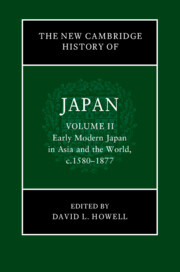Book contents
- The New Cambridge History of Japan
- The New Cambridge History of Japan
- The New Cambridge History of Japan
- Copyright page
- Contents
- Figures
- Maps
- Tables
- Contributors to Volume II
- Preface
- Frontispiece
- Introduction
- Part I The Character of the Early Modern State
- PART II Economy, Environment, and Technology
- Part III Social Practices and Cultures of Early Modern Japan
- 13 Religion in the Tokugawa Period
- 14 The Medical Revolution in Early Modern Japan
- 15 Flows of People and Things in Early Modern Japan
- 16 Labor and Migration in Tokugawa Japan
- 17 The Tokugawa Status Order
- 18 On the Peripheries of the Japanese Archipelago
- 19 The Early Modern City in Japan
- 20 Popular Movements in Early Modern Japan
- 21 Civilization and Enlightenment in Early Meiji Japan
- Index
- References
17 - The Tokugawa Status Order
from Part III - Social Practices and Cultures of Early Modern Japan
Published online by Cambridge University Press: 15 January 2024
- The New Cambridge History of Japan
- The New Cambridge History of Japan
- The New Cambridge History of Japan
- Copyright page
- Contents
- Figures
- Maps
- Tables
- Contributors to Volume II
- Preface
- Frontispiece
- Introduction
- Part I The Character of the Early Modern State
- PART II Economy, Environment, and Technology
- Part III Social Practices and Cultures of Early Modern Japan
- 13 Religion in the Tokugawa Period
- 14 The Medical Revolution in Early Modern Japan
- 15 Flows of People and Things in Early Modern Japan
- 16 Labor and Migration in Tokugawa Japan
- 17 The Tokugawa Status Order
- 18 On the Peripheries of the Japanese Archipelago
- 19 The Early Modern City in Japan
- 20 Popular Movements in Early Modern Japan
- 21 Civilization and Enlightenment in Early Meiji Japan
- Index
- References
Summary
This chapter describes the Tokugawa status order and its change over time by highlighting its constituent groups and their status-mediating functions. The Tokugawa state relied on locally specific status groups to govern the population. These groups were defined by land and occupation and possessed a high degree of autonomy in regulating their own affairs. The chapter characterizes the most common types of groups – retainer bands, villages, block associations (chō), monastic communities, guilds, and outcaste associations – and explains how status was assigned, expressed, and negotiated between the state and these groups, drawing on notions of occupation, privilege, duty, and household as well as on a system of household registration. The chapter surveys the development of the status order in three stages: the formative period of pacification in the sixteenth and seventeenth century; its maturation under Tokugawa rule; and the conditions and process of its dismantling around the Meiji Restoration of 1868.
- Type
- Chapter
- Information
- The New Cambridge History of Japan , pp. 567 - 602Publisher: Cambridge University PressPrint publication year: 2023

